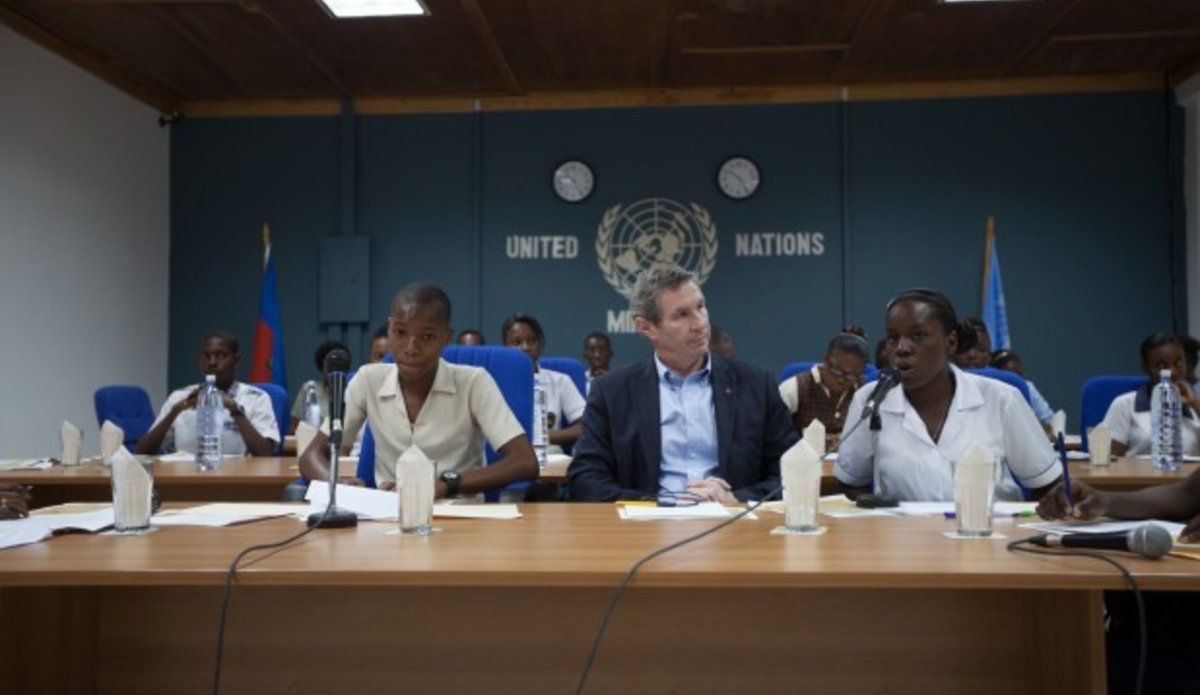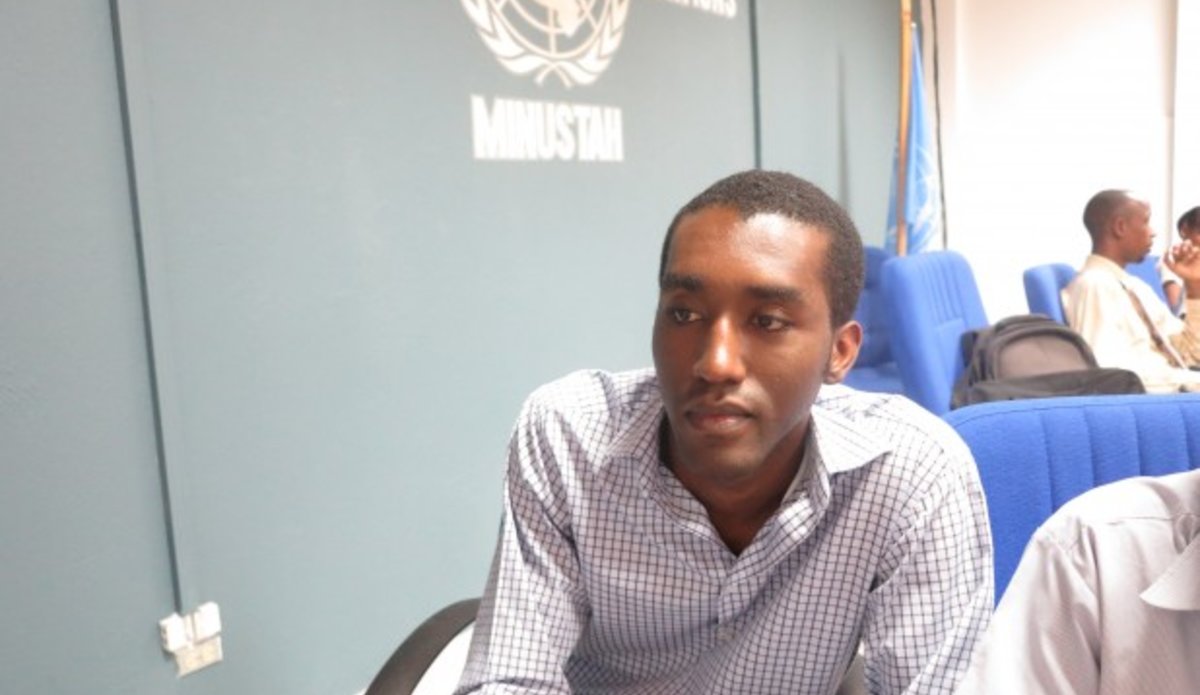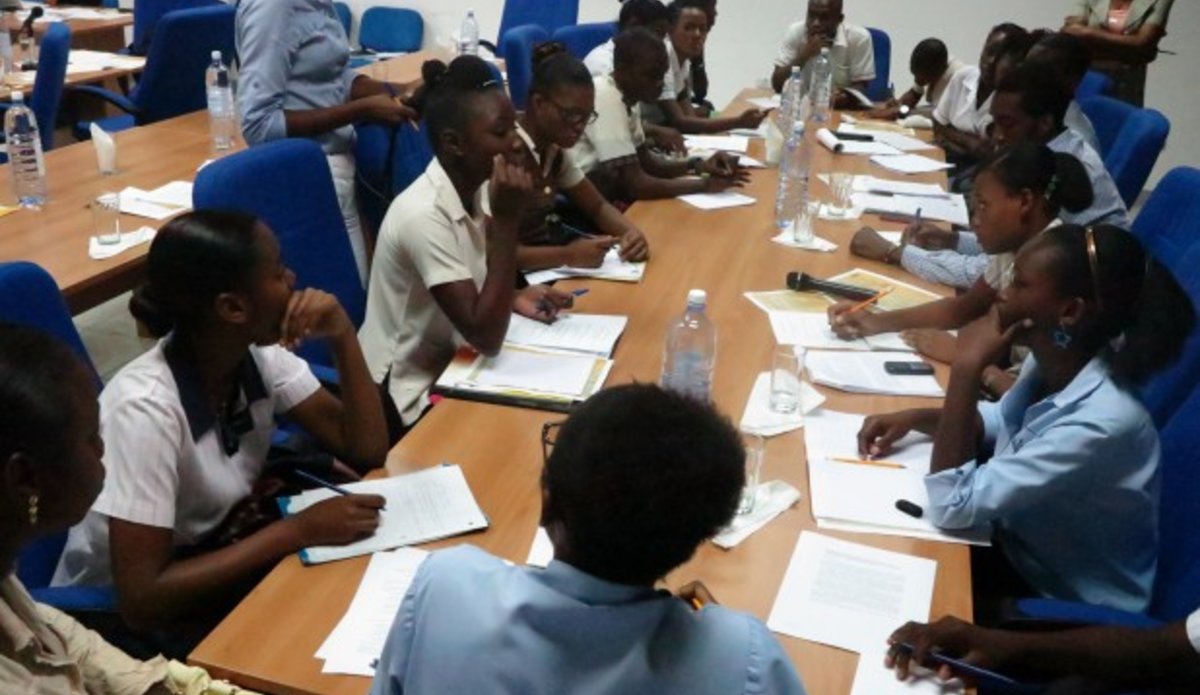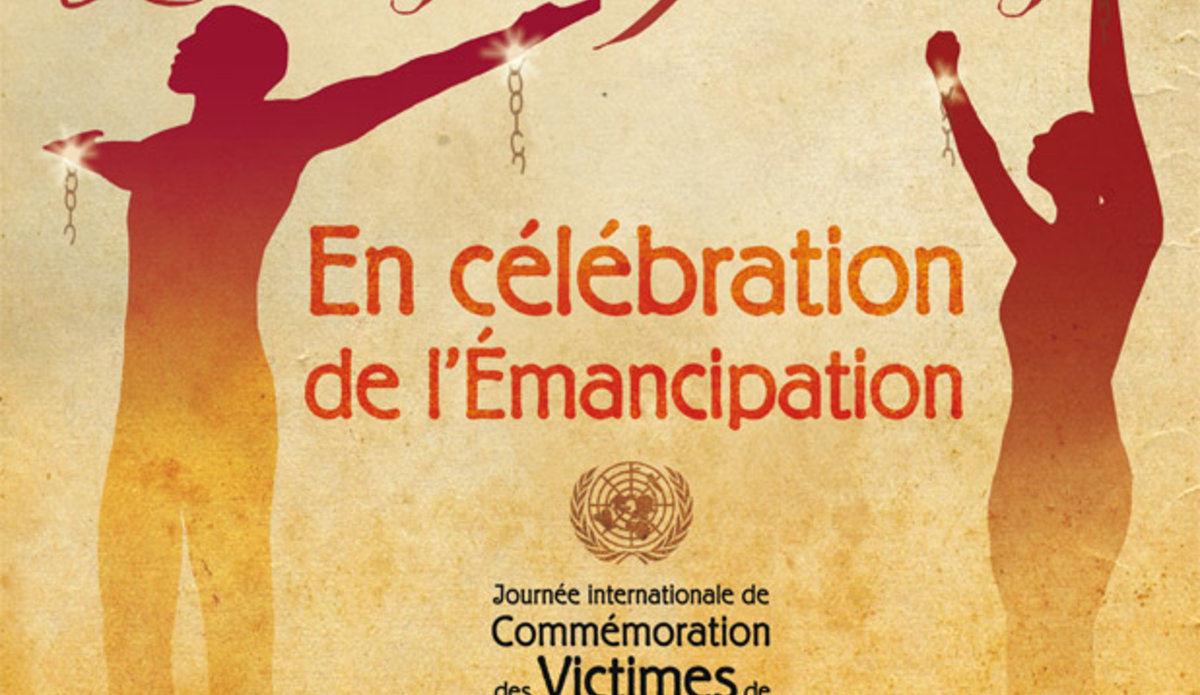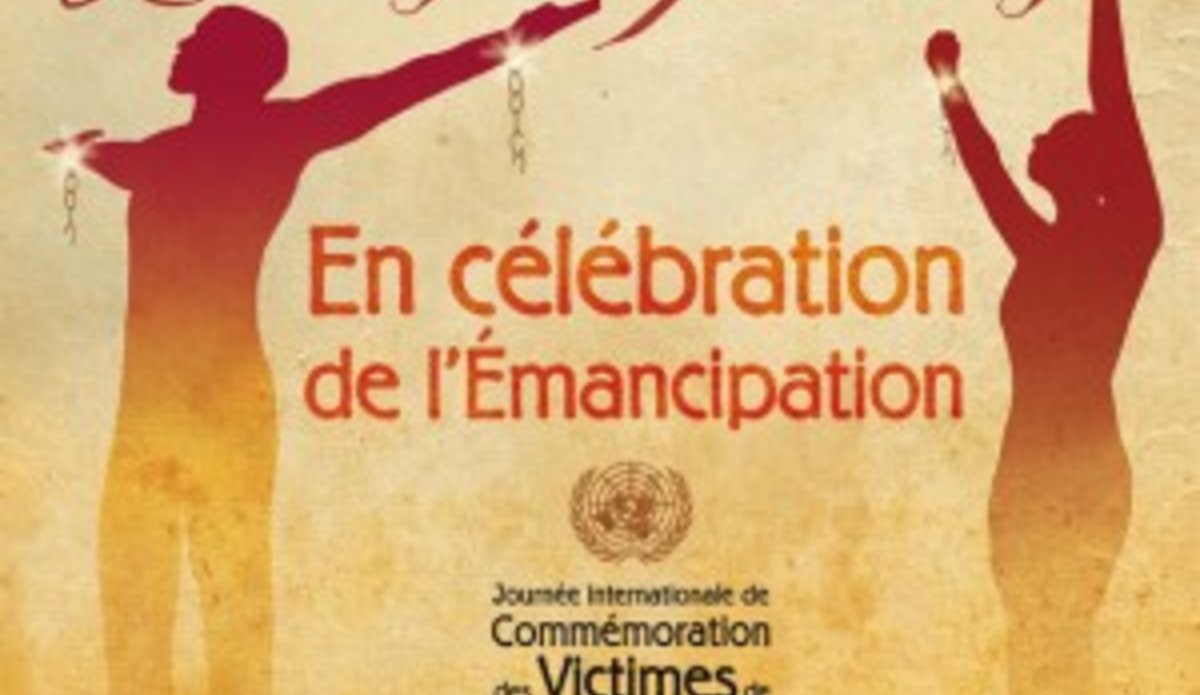'Haiti & beyond': students from three continents re-trace the route of victims of slavery Haïti et au-delà » : Des étudiants des trois continents retracent la route des victimes de l’esclavage
Dakar, Madrid, New York and Port-au-Prince – these are the four sites of a major video conference for youth organized by the United Nations and UNESCO on the occasion of International Day of Remembrance of the Victims of Slavery and the transatlantic slave trade.
Haiti, the first black nation in history to break the chains of slavery, has built its independence on the struggle for the freedom of mankind. But what was the impact on the rest of the world? Why is it important for younger generations to remember slavery and the transatlantic slave trade? These are the questions that hundreds of African, American, Spanish and Haitian youth attempted to address at a conference titled 'Victory over Slavery: Haiti & Beyond.'
The victory [in Haiti] inspired slave rebellions and abolitionist movements in the United States, Brazil and Venezuela," said Peter de Clercq, the Deputy Special Representative of the Secretary-General of the United Nations in Haiti, in his introduction to the conference.
Four young Haitians from schools in the capital, Port-au-Prince – and each a member of the network of schools affiliated to UNESCO – shared with fellow students on three continents what they know about the period of slavery in Haiti and revolution. Uprooted from Africa to work in "inhuman" conditions in the sugar cane fields of the then French colony, the slaves "were branded with a hot iron by their 'owner', dressed in rags, permitted to sleep in boxes in the ground, barely eating to satisfy their hunger, and without any leisure whatsoever... ".
It was a situation Fleuriot Yvens Joseph, of Normaliens Réunis college, likened to hell on earth in his presentation. The revolt was primarily that of individuals and fairly discreet before the situation burst into open conflict, leading to the abolition of slavery on the island of Hispaniola in 1801, and the independence of Haiti in 1804.
"An appointment for giving and receiving"
Meeting together in Dakar, Malian and Senegalese students shared the shock felt during a school visit to Ile de Gorée – the so-called House of Slaves where ' the door of no return ' can be found: "We discovered the difficult living conditions endured by black slaves before their voyage to the Americas," says a young student from Dakar. It was a visit that enabled the pupils to understand how slavery is a serious violation of human rights.
Responding to a question posed by a young Haitian, Spanish students – descendants of slave traders under the Spanish Crown – recognized the immense harm caused by their ancestors, without feeling guilty themselves. "Nevertheless, this is why we mobilize today in our schools (...) against racism," said one Spanish youth.
One Haitian student sparked applause across the oceans when he called for "dialogue between nations." At the end of the conference, each participant learned from his or her counterpart, aspects of their respective history and pieced together a puzzle – the path towards the dehumanization of slaves, while at the same time identifying ways to prevent prejudice through love, dialogue and equality for all.
Emerging issues
On either side of the Atlantic, Haitians and Africans expressed the difficulty they have in finding confidence within themselves. "We, the descendants of slaves, feel bound by invisible mental, psychological chains... [we suffer from] the effects of trauma suffered by our fore-bearers - which they have passed on through their attitudes," said Cassandra, in response to a question.
In turn, the testimonies of young Americans, themselves descendants of slaves, reflected the hope of overcoming this feeling of discomfort through education. Through dance and theatre, using the language of their ancestors, two young women proclaimed their pride in being citizens and free.
Discussions during the video conference highlighted a certain lack of dialogue between African and Haitian culture. “Did you know that Africa had its own heroes?" asked a student from Dakar. "No! They do not teach us the history of Africa and its people," replied a Haitian, scribbling in his notebook the name of Senegalese President Léopold Sédar Senghor, co-creator of the Négritude concept.
"I never learned that in Africa blacks were opposed to the domination of other peoples," confessed Fleuriot at the end of the conference. The young man goes further and considers it an "error" to have "hidden this page of the history of black people from Haitian youth."
Nimrod Rock, a young Haitian history teacher sees this forgetfulness as "censorship applied to the Black Continent for its complicity with European slave traders," he says. Teaching this aspect of African history could help Haitians "to reconcile with their roots – and fill the void that is causing a loss of confidence."
Richard Richemond, program manager at the National Commission for UNESCO, suggested in this sense that the government reform the education curricula.
The video conference, organized within the framework of two days of festivities focussing on Haiti at the United Nations in the presence of Michaëlle Jean, the Special Envoy of UNESCO to Haiti, and the Haitian artist Emmeline Michel, also allowed young participants to discover a sculptural work by the American architect of Haitian origin, Rodney Leon... Entitled 'Arche du retour’ [Ark of Return], this public monument will be erected shortly in a courtyard of the United Nations Secretariat in New York in memory of the victims of slavery.
Antoine Adoum Goulgué
http://webtv.un.org/search/transatlantic-slave-trade-commemoration-globa...
Dakar, Madrid, New York et Port-au-Prince, tels sont les quatre sites d’une grande vidéoconférence des jeunes organisée par les Nations Unies et l’UNESCO à l’occasion de la Journée internationale du souvenir des victimes de l’esclavage et de la traite transatlantique.
Haïti, première nation noire de l’histoire à briser les chaines de l’esclavage, a construit son indépendance sur la lutte pour la liberté de l’Homme. Mais quelle en a été l’impact dans le reste du monde ?
Pourquoi est-il important pour les jeunes générations de se souvenir de l’esclavage, et de la traite transatlantique des esclaves ? Telles sont les questions auxquelles ont tenté de répondre des centaines de jeunes africains, américains, espagnols et haïtiens lors d’une conférence intitulée « Haïti et au-delà : victoire sur l’esclavage ».
Cette victoire des esclaves a inspiré « les rebellions et les mouvements abolitionnistes aux Etats Unis, au Brésil et au Venezuela », a souligné en introduction Peter de Clercq, le Représentant spécial adjoint du Secrétaire général des Nations Unies en Haïti.
Quatre jeunes haïtiens issus de lycées de la capitale, tous membres du réseau des écoles affiliées à l’UNESCO, ont partagé avec leurs camarades des trois continents ce qu’ils savent de la période de l’esclavage en Haïti et de la révolution.
Arrachés d’Afrique pour travailler dans des conditions « inhumaines » dans les champs de canne à sucre de la France d’outremer, les esclaves « étaient marqués au fer chaud à l’initiale du propriétaire, vêtus de haillons, dormant dans des cases à même le sol, mangeant à peine à leur faim, sans loisir aucun… ».
Une situation que Fleuriot Yvens Joseph, du collège les Normaliens Réunis, a comparée à l’enfer dans sa présentation. La révolte était d’abord individuelle et discrète avant d’éclater en conflit ouvert, menant à l’abolition de l’esclavage sur l’ile en 1801 et l’indépendance d’Haïti en 1804.
« Le rendez-vous du donner et du recevoir »
Réunis à Dakar, les étudiants maliens et sénégalais ont, eux, partagé leur choc ressenti lors d’une visite scolaire sur l’Ile de Gorée où se trouve ‘la porte du non-retour’ : « Nous avons constaté les difficiles conditions de vie qu’ont endurées les esclaves noirs en attendant leur voyage en Amérique », dit un jeune de Dakar.
Une visite qui leur a permis de comprendre combien l’esclavage est une grave violation des droits de l’homme.
Répondant à une question des jeunes haïtiens, les étudiants espagnols, descendants d’esclavagistes au solde de la Couronne espagnole, ont reconnu l’immense tort causé par leurs ancêtres, sans pour autant se sentir eux-mêmes coupables. « C’est pour cela que nous sommes mobilisés aujourd’hui dans nos lycées (…) contre le racisme », explique une jeune espagnole.
Appelant au « dialogue entre les nations », une jeune haïtienne a suscité les applaudissements au-delà des océans. A l’issue de cette conférence, chacun à appris de l’autre une partie de son histoire et reconstitué puzzle d’un chemin de déshumanisation des esclaves, en identifiant les moyens de prévenir les préjugés par l’amour, le dialogue et l’égalité entre tous.
Des questions émergentes
Mais, de part et d’autre de l’Atlantique, haïtiens et africains ont exprimé la difficulté qu’ils ont d’avoir confiance en eux-mêmes. « Nous les petits-fils d’esclaves, nous nous sentons liés par des chaînes mentales, psychologiques invisibles, conséquences du traumatisme subi par nos grands-parents et qu’il nous ont transmis à travers leur attitudes », dit Cassandra, en réponse à une question posée.
A leur tour, des témoignages des jeunes américains, eux-mêmes descendants d’esclaves, laissent transparaitre l’espoir de vaincre ce sentiment d’inconfort par l’éducation. A travers la danse et le théâtre, dans la langue de leurs ancêtres, deux jeunes femmes crient leur fierté d’être libres et citoyennes.
Les débats ont mis en lumière une certaine absence de dialogue entre la culture africaine et la culture haïtienne. « Savez que l’Afrique a eu ses propres héros? », interroge une étudiante depuis Dakar. « Non ! On ne nous enseigne pas l’histoire de l’Afrique et de ses hommes », rétorque une haïtienne, griffonnant sur son cahier le nom du président sénégalais Léopold Sédar Senghor, fer de lance du mouvement de la négritude.
« Je n’ai jamais appris qu’en Afrique, des Noirs se sont opposés à la domination des autres peuples », avoue Fleuriot à la fin de conférence. Le jeune va plus loin, et considère comme un « faute » le fait d’avoir « caché cette page de l’histoire du peuple noir au jeunes Haïtiens ».
Si Nimrod Rock, un jeune professeur d’histoire haïtien, voit cet ‘oubli’ comme une « censure apposée au continent noir pour sa complicité avec les esclavagistes européens », il pense toutefois que l’enseignement d’une partie de l’histoire africaine peut aider les haïtiens « à se réconcilier avec leurs racines et combler le vide qui est à l’origine de la perte de confiance ».
Richard Richemond, responsable de programmes à la Commission Nationale pour l’UNESCO, suggère en ce sens au gouvernement une réforme des curricula de l’enseignement.
La vidéoconférence organisée dans le cadre de deux jours de festivités autour d’Haïti au Siège des Nations Unies en présence de l’Envoyée spéciale de l’UNESCO pour Haïti, Michaëlle Jean, et de l’artiste haïtienne Emmeline Michel, a aussi permis aux jeunes de découvrir en avant-première le travail de l’architecte américain d’origine haïtienne Rodney Leon. Intitulé ‘l’Arche du retour’, le monument public sera érigé prochainement dans la cour du Secrétariat de l’ONU à New York en mémoire des victimes de l’esclavage.
Antoine Adoum GOULGUE-UN/MINUSTAH
Visualiser la vidéoconférence par le lien ci-dessous
http://webtv.un.org/search/transatlantic-slave-trade-commemoration-globa...
 ONU
ONU Nations Unies Maintien de la paix
Nations Unies Maintien de la paix

